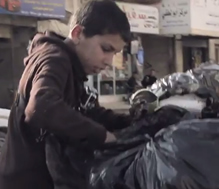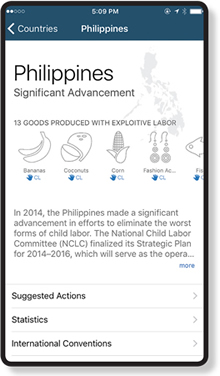Please note: As of January 20, 2021, information in some news releases may be out of date or not reflect current policies.
News Release
The power of open data: ending child labor in the digital age
 |
|
Qusai, 13, scavenges through trash in "Jordan: Living on Scrap," a Promising Futures documentary, funded by the U.S. Department of Labor. |
WASHINGTON — Thirteen-year-old Qusai was about to enter 6th grade when the conflict in his native Homs, Syria caused him to drop out of school, flee with his family to Jordan and spend his days sifting through garbage on the street to survive.
In school, Qusai dreamed of being an engineer or a doctor. Now, he says, "We work because we need to we need the money... where do we get rent from if we do not work?"
The past year has seen a number of crises — the Syrian refugee crisis, the West African Ebola outbreak, a devastating earthquake in Nepal and the mass migration of unaccompanied minors desperate to escape violence and economic insecurity in parts of Central America. These crises have made millions of children more vulnerable to the worst forms of child labor.
Children who enter the labor force at an early age are robbed of their childhoods, their right to an education and a fair shot at a better life. They are more vulnerable to forced labor, trafficking, work that endangers their health and safety, and physical and emotional abuse at the hands of their employers.
 |
The 2014 Findings on the Worst Forms of Child Labor, released today by the U.S. Department of Labor's Bureau of International Labor Affairs, documents how these recent crises and global poverty impact the lives of the world's most vulnerable children and families. The report outlines progress made by governments around the world to address the issue and recommends steps they can take to improve their efforts to end child labor. Mandated by the Trade and Development Act of 2000, it assesses efforts by 140 countries to reduce the worst forms of child labor by determining whether they have made significant, moderate, minimal or no advancement from year to year. The 2014 report finds nearly 60 percent of the countries covered made a moderate to significant advancement.
Deputy Secretary of Labor Christopher P. Lu announced the report this morning during the "Power of Open Data: Ending Child Labor in the Digital Age" event in Washington, D.C., at the offices of 1776, a global business incubator that raises seed funding to help startups transform industries that impact millions of lives. He also unveiled ILAB's new mobile application, Sweat & Toil: Child Labor, Forced Labor, and Human Trafficking Around the World, which streamlines the wealth of research in ILAB's reports and makes it available anytime or anywhere.
 |
|
Download the app here. |
"Whether facing economic instability, health epidemics, natural disasters, political conflict or chronic poverty, we as a global community have an obligation to protect our children," Deputy Secretary Lu said. "This report and the new mobile app are intended as practical tools to identify the problem and help governments around the world firm up the foundations of such protections, so that children don't fall through the cracks."
Sweat & Toil is a comprehensive resource that documents child labor and forced labor worldwide. Developed by Presidential Innovation Fellows at the U.S. Labor Department, the app contains information on goods produced by child labor or forced labor and the latest findings on the worst forms of child labor. It digitally reduces thousands of pages to fit into the palm of your hand. For the first time, ILAB's research is portable, searchable, and available offline.
Data from the app is also available in an open format through the department's next-generation Application Programming Interface, fulfilling the promise of the Obama administration's Open Government Initiative to make more data readily available and useful to the public. Developers can use this data in their own applications, data visualizations and mashups with other data sets, while data scientists can use it to fuel further research.
"ILAB's reports on child labor and forced labor raise awareness and provide governments and civil society with tools to improve the rights and protections for these vulnerable workers," said Deputy Undersecretary for International Labor Affairs Carol Pier. "My hope is that our new Sweat & Toil app and the open data are used to promote social good, enabling more people to empower themselves with knowledge about these issues. We want more people asking questions, taking action and demanding change."
More information about the report is available at http://www.dol.gov/endchildlabor/. Email ideas to improve the app, submit information regarding child labor or forced labor globally, or ask questions related to technical issues through GlobalKids@dol.gov. Join the conversation on Twitter by using #EndChildLabor and tagging @USDOL
ILAB leads the U.S. government's efforts to ensure that workers around the world are treated fairly and are able to share in the benefits of the global economy. To these ends, ILAB designs programs in part based on the research the bureau conducts on child labor and forced labor, and it has funded 292 projects in 90 countries to combat the worst forms of child labor by providing assistance to vulnerable children and their families.
- Read this news release en Español.
